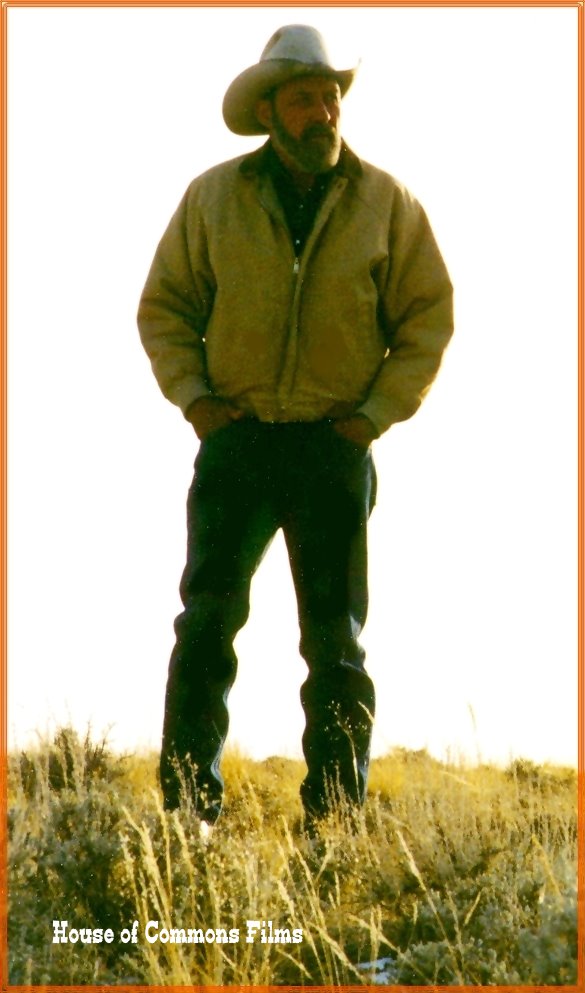
Bob Edgar in the Oregon Basin – November 2003 –Photo: House of Commons
BOB EDGAR 1939-2012 , Cody Wyoming

Bob Edgar in the Oregon Basin – November 2003 –Photo: House of Commons
Obituary:BOB EDGAR 1939-2012 , Cody Wyoming
¶ Historian, archaeologist , preservationist , author, artist , marksman and firearms specialist, hunting guide, and trapper , naturalist and conservationist
One of the last chapters of the American Old West closed Friday evening April 20 with the passing of Bob Edgar, 72, of Cody Wyoming , founder of the Old Trail Town frontier museum and an internationally acclaimed historian and archaeologist . If the iconic western gentleman had need of a proper resumé, it would have also included artist, author , sharpshooter and firearms specialist, hunting guide and trapper, naturalist and conservationist (and along the way , destroyer of Jeeps in the line of duty ).
Bob Edgar was destined to be a historian ; the aggregator of the Old West that Cody Wyoming so dearly hung its hat on. While the community of Cody diverted much of its energy in promoting its western image through rodeo and the growing Buffalo Bill Historical Center art institution , Bob Edgar chose to capture the real grist and edifice of the Old West and put a foundation under it . By recovering the artifacts of the past and giving them a new home and extended life at Old Trail Town , Bob Edgar assured the frontier life and pre-20th century history of northwest Wyoming all the way back to the Ice Ages and earliest peoples will be experienced by generations to come. The greatest tool in Bob Edgar’s toolbox for recovering the West was to become that West along his storied way . Few would doubt that Bob Edgar was the real live image of the American West before automobiles and airplanes. The veracity and dedication of his life’s work went far beyond the fables, the fictional accounts, and the faux western constructs of Hollywood and Madison avenue to deliver the American West using its bones and grist , gunpowder and charcoal, it’s dark leathers and black iron , its handhewn woods and mud chinks , as built by forgotten men with stone tools or forged axe and remembered by Bob Edgar’s selfless toil to edify it all.
Cody folks have been blessed with the best of two possible “ Western “ worlds...a veritable Smithsonian institution of the art and academics of the West at the BBHC, and just three minutes away a living Williamsburg-like frontier village bursting with history that is but one step removed . If the BBHC is the cerebral artistic and professorial experience , Bob Edgar’s Old Trail Town is the salt of the earth. Trail Town can be experienced with all five senses , also in a scholarly way where frontier life becomes art of its own volition.
The trail to Trail Town was a long and winding travail , and not always a happy trail , however.
Robert Wilburn Edgar was the firstborn of Paul G. Edgar and Marjorie (Downer) Edgar , delivered by midwife on July 27 , 1939 at their rustic home at the base of Polecat Bench northeast of Powell Wyoming.
An early love of the outdoors and awareness of local history was infused into young Bob and his brother Larry at a very early age when the family resided at the small oilfield company camptown in Oregon Basin. Paul Edgar , who was part Comanche Indian , was an oilfield production man for the Ohio Oil Company, Husky Oil , and eventually Marathon Oil companies. Bob and Larry spent countless hours in the sandstone and cedar breaks of the Badlands, having little want or need of the slow glimmer of Cody town till the family moved there in 1950 with younger sister Helen and soon kid brother Dave , completing the Edgar family . Paul commuted to the oil patch while Marjorie operated her successful home interior and furnishing business in Cody till they retired. Bob and Larry retreated to the sagebrush and ridgelines as often as possible.
Bob was educated in the Cody public schools , graduating Cody high School with honors in 1957 and attending fledgling Northwest Community College in Powell to study art and archaeology, recieving an Associates Degree in 1961. In a parallel educational track , Bob was already an accomplished hunter and trapper by the time he left high school, employed by outfitters , and dived deeply into the lore and functionality of firearms . Outside the classroom Bob went about learning important skills about horsecraft and by virtue of a service station job maintaining Jeeps , not that the latter did him much good, since he destroyed three of them in the line of duty. It wasn’t the Jeeps’ fault.
While at NWCC , Bob painted a large mural --still there last we knew---of the school’s “ Trapper” mascot in the personage of mountain man John Colter, a member of the famed Lewis & Clark Expedition of 1805-06 who went off on his own and became the first Anglo to see northwest Wyoming. As serendipity would have it, just five years later Bob Edgar gestated Old Trail Town across the river from the geothermal area known as “ Colters Hell “ on the west edge of Cody . Colter the mountain man most certainly walked the grounds of Trail Town’s future location and the site of Bob Edgar’s own family home and hub of his lifelong historical legacy.
Bob had inquired about a lonely primitive one room cabin way out west of Cody above the Demaris “ Bronze Boot” hotsprings that was owned by a colorful worldly gentleman named Bill de Maris---who may or may not have been the out of wedlock son of one William F. “ Buffalo Bill Cody “ , the town’s founder and icon. Demaris owned a lot of property thereabouts , subdivided on paper, including one lot off the highway with the little cabin moved into town their from Vic Arland’s c. 1878 trading post on Cottonwood Creek a few miles due north of present day Cody by German sculptor named Winold Wreiss in 1935 for his studio, but it had been unoccupied for years. DeMaris leased it to Bob for $ 1.00 per year to make it legal. It had no electricity or running water. Acquaintances of Bob at the time recall he would extinguish to lone candle that illuminated the interior with his . 22 pistol.
Bob had been taken by a very attractive waittress new to Cody from Texas , Janice Birchfield, and married her in 1959. They later divorced after having two daughters, Cathy and Susan. Jan was tragically killed in a car accident near Meeteetse. Bob became enamored once again , this time with Terry Deutch of Sheridan whom he married and she moved into the Arland cabin , and they had a daughter Sherri who only ever knew Trail Town as home. Such were the humble beginnings of Old Trail Town and the personal touchstones of Bob Edgar’s life.
In his self-made career, Bob Edgar received many awards and accolades , accruing a long list of national and international recognition from the Smithsonian Institution all the way down to local service clubs and everything inbetween.: Governor’s awards, state archaeological society awards and serving as Vice President of same, NWCC Distinguished Alumni , American Travel Writer’s “Phoenix” award for distinguished conservation , serving on the state of Wyoming BLM advisory board , and man other meritorious accolades that Bob was too humble to record as they came over the transom on a regular basis.
Among other virtues, Bob Edgar did not seem to have the word “ No “ in his lexicon. He was by example the embodiment of a true western gentleman , and lived up to the Cowboy Code of courtesy and generosity to a fault. Few can say that of themselves. Bob was too humble to , but all around him knew it. Bad words seldom issued from Bob Edgar’s lips, and when they did were either well deserved or in a purely historical context.
Bob was often asked to speak formally , sometimes in high places such as the gilded Westerner’s Club in Chicago which he did , but was much more gratified doing show and tells to schoolkids in Meeteetse or Cody or anywhere within driving range . Magazine writers appreciated the wellspring of Bob Edgar’s work and countless pages were generated in publications at home and abroad . If the topic was the American West , Bob was on the contact list , but the unspoken truth was the writers and reporters wanted as much as anything to see him shoot his Colt 45 pistols with the accuracy of a neurosurgeon.
Bob Edgar became a world class sharpshooter, being gifted with extraordinary eyesight and hand control plus an intimate knowledge of projectile weaponry. Years of practice and hundreds of thousands of spent rounds honed his skills to the confidence level of being able to shoot objects from people’s mouths and hands at 40 paces with the deadly force of a Colt 45. Folks honestly were not considered to be on the social register in Cody unless they had something blown off an appendage by Bob Edgar’s pistol at some point. Or put another way , Bob was one of the few men in America who shot a heavy caliber handgun directly at his own wife ( Terry ) thousands of times and got away with it. Law Enforcement often looked the other way when Bob did some late night sport shooting in downtown Cody or Meeteetse , autographing buildings with bullets. One night outside the back of the Irma Hotel in Cody , Bob was monogramming a playing card for a bar patron who held it up against a wooden utility pole to capture the bullet, and it did: the card was summarily and safely holed, but killed the electricity at the police station a half block away. Prudence prevented Bob from copping to that ...
Yet Trail Town stood on the brink of doom four times due to horrendous legal issues and an irresolute marriage , and another time it nearly burned to the ground when a group of US Cavalary reenactors camped just west by the Cody Stampede rodeo grounds touched off a cannon and the sparks ignited a prairie fire that nearly consumed the buildings and contents on July 3, 1993.
In a cruel twist of fate, with those legal battles behind him and the road ahead for Trail Town clear for the first time ever, Bob’s health began failing about the same time. Back when he was 18 years old, Bob had a defective kidney removed and lived the remainder of his life with one kidney , ignoring doctor’s advice to take it easy and treat his body gently . Bob did not treat his body gently ... he was a physically strong man and engaged the world around him with great vigor, hard work, and impossible hours plus countless forays into the wild.
Once while guiding an elk hunter in the Thorofare , he jumped over a fallen tree only to land squarely with both boots on the back of a snoozing black bear in its day bed. Another time while shooting a .45 Colt handgun alone, the cylinder exploded and drove shrapnel into his leg and arms, probably the only time in the hundreds of thousands of round he fired from guns that human bodily harm was done. Another time while doing log work alone, he accidentally tore open his leg with a drawknife and nearly bled to death.
Bob survived a nasty bout of tularemia ( also called Rabbit Fever) when young, but as a middle aged man he began having mini-strokes ( transient ischemic attacks, or TIA ), no doubt exacerbated by reduced kidney function and his general adamance to lighten up the stress he was inflicting on his own body from his rugged lifestyle and the physical work of wrangling whole buildings. To a fault Bob was averse to seeing doctors or even taking common OTC pain relievers, preferring “ Cowboy Up Medicine” and/or ‘horse doctoring’ for the more serious aches , pains and contusions , of which there were quite a few. A faulty propane heater in a camp trailer at the Pitchfork Ranch in the mid-90’s left Bob unconscious, and it is speculated this may have accelerated the onset of his crippling dementia. Although he hid it well , it became obvious by the turn of the millennia that Bob’s mental faculties were slowly deteriorating , becoming acute from ~2005 on and leaving him bedridden without the ability to speak in recent years . Dementia claimed him in the Spring of his 72nd year , with so much of his life’s work undone, but with few if any regrets.
Bob Edgar was a lifelong resident of the western Big Horn Basin of Wyoming and became its chronicler of pre-1900 life there, both on paper and in selflessly preserving the physical heritage. He seemed born to a destiny of both preserving the history and living it . His life and his work merged seamlessly.
There were far too many projects or collaborations in Bob Edgar’s professional life to list here, but a few major milestones stand out. In 1960-63, Edgar and George Dabich scoured the entire state of Wyoming , inventorying and mapping Paleo-Indian archaeological sites at the behest of the Buffalo Bill Historical Center’s first director, Dr. Harold McCracken , himself a world renowned researcher, explorer, and old-school naturalist who secured Smithsonian , National Geographic Society, and private funding to endow Edgar’s position as the BBHC’s Director of Archaeologic Survey and Excavations from 1960-67.
Edgar and Dabich assisted by Larry Edgar were the principal excavators of the Mummy Cave project 35 miles west of Cody near the mouth of Blackwater Creek beginning in 1963 before the project was joined by the Smithsonian’s Dr. Waldo Wedell. Mummy Cave yielded an unbroken archaeological and climatological record going back over 9,000 years, including the discovery of a very well preserved pre-Columbian human mummy , obviously a man of some esteem and buried with a treasure trove of possessions who was interred around 1250 years previously , some 750 years before Columbus sailed and 350 years before modern Plains Indian tribes moved into the Absaroka-Yellowstone region. Mummy Cave became an encyclopedia of aboriginal life in the Rocky Mountains.
Of the myriad events that occurred at Trail Town , the pinnacle came in June 1974 when the remains of John “ Liver Eatin’ “ Jonhston --Civil War veteran, mountain man , and former Sheriff of Red Lodge Montana---were reburied at trail Town , beginning the pioneer cemetary that today holds seven notable frontier characters. Johnston was the real life model for the 1972 Robert Redford film “ Jeremiah Jonnston “ a semi-fictional screenplay based on Vardis Fisher’s biography “ Crow Killer “ . Redford himself came to Cody to act as pallbearer for the man he portrayed onscreen , whose grave was in danger of being lost to a freeway project in Lancaster California. Bob Edgar had taken an interest in Johnston’s life and offered Trail Town as a permanent home for the storied mountain man. Truth be told, Redford and Cody artist James Bama paid the extraneous expenses of the reburial, anonymously , even as reporters descended on Cody and news accounts of the Reburial of Liver Eatin’ Johnston saturated the global media. This event established Trail Town’s reputation as a storehouse of Old West history in the larger world outside of Cody Wyoming, and many more film, television , and print media events only added to that media legacy , and continue to this day. Bob Edgar has done countless on-camera interviews over the years. A pilot of a western genre movie , “ Absaroka” was filmed at Trail Town and the nearby mountains in 2008. Trail Town with its frontier countenance has served for countless community events , gatherings and presentations , more than a few weddings , and musical performances.
[ Trail Town website is www.oldtrailtown.org ]
On 1982 a most curious chain of events drew Bob Edgar into yet another sensational national news splash involving the Old West A psychic in Virginia named Virginia Mauricio claimed the spirit of a Crow Indian chief was contacting her and wanted to go home to his people. While skeptical, Bob organized a forensic archaeological search in the sandstone rims above the Whit Ranch west of Meeteetse , owing to his research of other native American burial sites in the immediate area and the specificity of the psychic’s vision. Miraculously ( or not ), the splendored bundle burial of the great Crow chief Blackfoot were found by 17-year old Willie Plainfeather , son of Crow historian Plain Feather who lived to be 100. Chief Blackfoot ( Kam-Ne-But-Sa) was born in the Absaroka Mountains in 1795 and rose to Chief of all Chiefs , having the wisdom to keep his people out of the Indian Wars and away from the US Army by signing the Laramie treaty of 1868 which gave the Crow people hunting and fishing rights and passage , in exchange for neutrality. Under Bob Edgar’s direction, Blackfoot’s remains were carefully excavated , and the Chief reburied with full tribal honors.
Truth be told, Bob Edgar had a propensity for unburying Old West personalities to rebury them at Trail town. To wit : from the Palette 1 Ranch on the Greybull River , Phillip Vetter, a settler who was killed by a grizzly bear but not after writing a death note in his won blood; Jim White, one of the most notable of the buffalo hunters ; William Gallagher and Blind Bill Houlihan found on Meeteetse Creek , two 1880’s outlaws involved in a love triangle at the notorious town of Arland now ghosted ; Belle Drury , soiled dove from early Meeteetse ; and Jack Stillwell, Civil War veteran and frontiersman have all joined Liver Eatin’ Johnston in Trail Town’s firmament. Whether Bob was acting as a historian , forensic archaeologist, mortician , or graverobber when moving these deceased folks around is a matter of some speculation , but the graves of Gallagher, Blind Bill, and Vetter would have been obliterated by backhoes or hydrology had Bob not relocated them.
A recurring theme in Bob Edgar’s life is his association with the area around Meeteetse, especially the huge Pitchfork Ranch begun by Count Otto Franc von Lichtenstein in 1878, the first of the large consolidated cattle ranches in northwest Wyoming , pencilling out at nearly 300,000 acres at is apex after WWII before the family divided it into the Pitchfork and 91 Ranches and spun off the bar TL to the lawyer handling the deal.
Bob Edgar struck a lasting friendship with Pitchfork ranch manager Cal Todd in the 1960’s while guiding and hunting the Greybull River , eventually becoming what amounted to a surrogate member of the Phelps-Belden family dynasty that owned the Pitchfork. Bob became the ranch’s hunting manager in 1968 , taking over the wrangling of hundreds hunters in search of Pronghorn, deer, and even a few elk from the Pitchfork every autumn while the ranch was entirely busy with roundup, weaning, pasturing and shipping, and remained hunting manager for nearly 30 years in an active big game conservation partnership with Cal Todd who cashed out and left the ranch in the early 70’s and later Jack Turnell , husband to Charles Belden granddaughter Frances “Lili” Abarr who managed the Pitchfork till the turn of the next century.
Noted American historical fiction author James Michener and his team researched the Pitchfork Ranch for Michener’s 1976 opus “ Centennial “ based on a fictional Colorado cattle ranch and dynasty that had a strong resemblance to the Meeteetse Pitchfork pantheon and setting. Edgar and Turnell did it one better when in 1978 they co-authored “ Brand of a Legend “ , a history of the Pitchfork, Meeteetse, the outlaw ghost town of Arland and the Greybull River country from late Pleistocene to the present day for the ranch’s 100th anniversary.
The following year, the duo published a book about the Wyoming woolgrower’s heritage centered on the Lucy and Lincoln Morrison family of the Wind River Basin . Lucy became known as the “ Sheep Queen of Wyoming” and was a distant relative of Turnell’s
Bob Edgar had always intended to write a much more comprehensive history of the Big Horn Basin and derived his portion of the Pitchfork and sheepherding books --from Prehistoric times till the close of the 19th century ---as seedstock. Regrettably , that seed never took stock before Bob lost his writing ability , yet he still left behind thousands of pages of handwritten accounts and research at Trail Town that has barely been sifted, grist for future historians and the next Micheners. Bob also assisted many other author’s with their own scholarly works on facets of Wyoming history and archaeology.
It was Edgar’s association with the Pitchfork that provided a core building block for Old Trail Town . The Belden family retained an impressive collection of Plains Indian artifacts and beaded clothing and many historical items that Otto Franc had acquired from the estate of early Greybull River aristocratic rancher Richard Ashworth when he bought him out to create the Z Bar T ranch headquarters five miles up from Franc’s own place. When Cal and Margot Belden Todd and Frances Belden were divesting themselves of the Pitchfork , they endowed Bob Edgar’s nascent Old Trail Town with a fireproof building and display cases to house the Ashworth collection , which is now the centerpiece of the exhibits.
During his heyday, Bob Edgar was perhaps better known in Meeteetse on a per capita basis than even Cody , and eventually acquired a cabin on some property up Meeteetse Creek. Bob is best remembered in Meeteetse for adding to the venerable Cowboy Bar’s decor with an assortment of interior bullet holes.
Edgar was able to recover and reassemble some 22 original frontier buildings for Trail Town, from tiny one room cabins all the way up to entire mercantile stores, doing it one log and one beam at a time. Most notable is the “Hole In The Wall “ cabin used by Butch Cassidy’s gang , moved here from near Kaycee Wyoming. As Trail Town evolved , Bob began populating a conjectural main street with building to resemble a town of the late 1800’s. The Henry Rivers Saloon from the mouth of the Wood River c. 1888 was the second structure and still serves drinks and hosts card games on occasion. The post office from the earliest town in the Big Horn Basin , called Bonanza over on the Nowood River is there. The Burlington Store, the Rice Ranch commissary , the original Shell WY store , a grainery , livery stable , George Taggart’s carpenters shop , and a complete blacksmith shop all from the 1890’s , and an ancient trapper’s cabin are there alongside the log home of the first Mayor of Cody . Completing the roster of edifices are a few one room residence cabins belonging to buffalo hunters, Custer’s Indian scout Curley , some homestead cabins , and a one room schoolhouse complete with desks and school supplies , plus a faux-frontier barn style building Bob built to house some of the wheeled coaches and provide a workshop area and occasional gathering hall. The outlier of Trail Town is littered with over 100 wooden vehicles , wagons , and implements of various sorts, with a bronze sculpture Mountain Man memorial garden. Oldtime rodeo cowboy Floyd Stillings was buried out back in 1997 at a remarkable gathering of living cowboys of renown, and Buffalo Bill’s grandson Bill Garlow Cody’s ashes were scattered there also.
However, many of Bob Edgar’s long term plans for Trail Town never came to pass , including a large circular log building fashioned after a round mountain lodge built to resemble a 3D Medicine Wheel to house his growing Pre-Columbian artifacts collections . It is something of a shame that Edgar was distracted by legal issues and a dissolving marriage that siphoned away much of the energy and time needed to advance the work of physical history. Trail Town teetered on the abyss no less than four times in its own history when Bob’s altruism in running the place as a gift to the public on meager cash donations clashed head on with larger well-heeled interests and their attorneys , and divorce. No less than two BBHC trustees or operatives , the executor of the Stock Foundation ( and himself BBHC legal counselor), the City of Cody , and the sale of half the financial interest in Trail Town to a Wall Street executive by Bob’s estranged wife all threatened to implode Trail Town in darkness and ruin.
Thankfully , all that passed by , including a seven year long legal battle with the latter , and Trail Town is now fully a 501 (c) 3 nonprofit foundation , The Musuem of the Old West , with a future as far as anyone can see.
It is a regrettable twist of fate that just as Trail Town’s legal and financial battles were won . Bob Edgar’s health began to fail him and his productive years were cut short.
Robert Wilburn Edgar was preceded in death by his parents Paul and Marjorie Edgar, his first wife Janice “ Jan” Birchfield Edgar and second wife Terry Deutch Edgar, and niece Cori Edgar . Bob Edgar was also preceded in death by three Jeeps , several 3/4 ton truck engines, and a few hundred thousand spent ammo cartridges and lots of rocks.
Survivors include brother Larry Downer ( Jan) Edgar of Meeteetse and their children Jim(Nickolette) and Lori of Cody ; sister Helen(Joseph) Edgar Sowerwine Venier of Wapiti and her children E.O. (Barbi) Sowerwine IV of Hulett, J.F. (Lisa)Sowerwine of Billings MT , Nicole (Kelly) Stevenson of Darwin Australia, and Jon ( Gina) Sowerwine of Wapiti ; brother David Paul ( Ramona) Edgar of Wasilla Alaska and their children Jared(Thomascina) Edgar, Mary(Adam) Sparrs, and Jenny(Jared)Freeman ; daughters Catherine(Rodney)Edgar Godard Dahlgren of Powell, Susan (Mike) Edgar Ward Welker of Pueblo Colorado ; Sherri Lynn Edgar of Cody and her son Jake, and Jill Roberts of Billings Montana , and two great grandchildren with a third on the way.
Those wishing to memorialize the life and work of Bob Edgar past present and future can contribute to the Museum of the Old West Foundation, P.O. Box 546 , or 1831 DeMaris Street , Cody Wyoming 82414. Contributions are tax deductible ( 501(c)3. and are used exclusively for the maintenance and advancement of Trail Town and the Museum of the Old West.
Cremation has occurred with ashes being dispersed privately at locations dear to the deceased , with a portion reserved for Trail Town proper. Public services there will be Saturday May 12 at 1:00pm ( nondenominational) with remembrances to follow. Trail Town will of course be open free of charge to the public that day.
Footnote ( all history requires footnotes) : On Tuesday , April 24, 2012 a small group of Bob Edgar’s immediate family and closest friends gathered at the neck of a windy canyon between the west end of YU Bench and Dry Creek not far from Meeteetse, at the site of a hidden cabin on the old Outlaw Trail across Wyoming, probably frequented by the likes of Butch Cassidy 125 years earlier. Half of Bob Edgar’s ashes were given back to the Earth amid some spoken words, a few songs, and the retort of three Colt 45 pistols not far from Bob’s beloved childhood home in the sandstone hills and cedar breaks of Wyoming, where his heart has always lived and will live forever.
For all else that happened along the trail of his life , Bob Edgar’s heart never failed him. It always faced the West.
#####
Bob Edgar
by Sherri Edgar (Edited By Ed Commons)
Bob Edgar was born in 1939 at his maternal grandparents farm, on Pole Cat Creek between Garland and Deaver in northwest Wyoming. The family lived at Grass Creek near Meeteetse, and later moved to Oregon Basin, when he was four years old. Bob went to a one room country school in Oregon Basin, with about fifteen other kids. Their school bus driver was an old, ex-sheepherder called Grandpa McCormick. The school bus was an army surplus power wagon. In nice weather, two or three kids rode their horses to school. During recess, they sometimes shot their bow and arrows along the creek bank, near the school.
Growing up in Oregon Basin, the only entertainment for the boys, was to explore in the sandstone ridges and hills looking for fossils, Indian arrowheads and buffalo skulls. They always carried their bow and arrows and practiced shooting and hunting all the time. There were many interesting places to go. Quite often they would walk to the Indian Hills (Cedar Ridge), on the east rim of Oregon Basin, where the old abandoned coal mines were.
0regon Basin is an early oil field located in the hills about fifteen miles southeast of Cody, Wyoming. The Oregon Basin School was located at the main camp on Texas Coulee.
At that time, the old stone cabins, mines, and coal slides were fairly intact. The mines were started in the late 1890's and operated until the early 1940's. One two-room cabin was made of stone and log. It still had everything left in it: the stoves, furniture, china and silverware in the cupboards, books on the bookshelves, and miner's caps with the carbide lamps on the front for seeing in the mines.
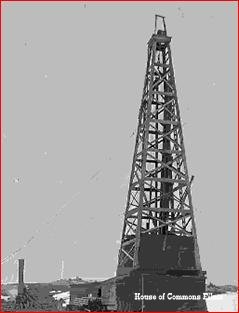
Typical early oil rig: Photo: Salt Creek Museum, Pauline Schultz, Curator
The boys used to enjoy stopping at the cabin on their trips, to eat lunch or get out of the weather. They went there one day in 1949 and found that someone had burned the cabin down. They were very sad. Later, they fixed up an old dug-out cabin in the hills for a hide out. Sometimes, they spent the night there. Bob, his brother Larry, and two or three other friends practically lived in the hills. They didn't even like to go to town very much. Finally, Bob's family moved to Cody, although his father continued to work in Oregon Basin.
Bob began big game hunting when he was fourteen and killed his first deer and antelope with a 30-30 rifle which had belonged to Earl Durand, an outlaw during the 1930's. The rifle had been found wrapped in a blanket under a canal bank behind Earl Durand's parents home in 1939 by men that were cleaning the ditch. Bob's father had bought the rifle from the man who found it. Durand killed game for people during the Depression. He was arrested for poaching in March 1939, broke jail and killed four law officers before his suicidal bank hold-up in Powell, Wyoming, where he died on March 29, 1939.
Soon Bob was able to acquire an old four-wheel drive Jeep. Then he and Larry and various friends could explore all over the area looking for pre-historic Indian sites, shooting, hunting, and trapping for furs. Often Bob just went alone.
As a boy, Bob belonged to the Cody Bowmen Archery Club and shot in many archery tournaments in the area and won a number of trophies and medals. He had killed big game with a bow and arrow when he was sixteen, and won the Wyoming State Big Buck Contest, for archery, with a big buck deer he killed near Oregon Basin. Bob also began shooting rifles and pistols as a boy and later won several trophies in fast draw shoots around Wyoming and Montana.
As a boy, Bob became friends with the Cody and Meeteetse government trappers. He went with them on their trap lines, both in the low country in the winter, and on the mountain sheep ranges in the summer. He learned their methods of trapping. For eleven years Bob made most of his winter income from trapping. When Bob was seventeen he had acquired a saddle horse and horse trailer. This made it a lot easier to travel into the mountains to hunt, trap, or explore for pre-historic Indian sites.
To make money in the fall, Bob began guiding big game hunters when he was seventeen; which he did for the next twelve years. He guided for Bud Hall who had the Circle H Ranch on the North Fork of the Shoshone River, for Les Bowman, Lynn Grooms and Chuck Poulson on the South Fork of the Shoshone River, and for himself. In addition to North and South Forks, they hunted on the Clarks Fork, the Greybull River, Owl Creek, and in the Thorofare Country.
Bob had an interest in drawing and painting since he was a small boy, and still does a certain amount of work every year, which helps some on the income. He does mostly Indian, animal, or western history subjects in his art.
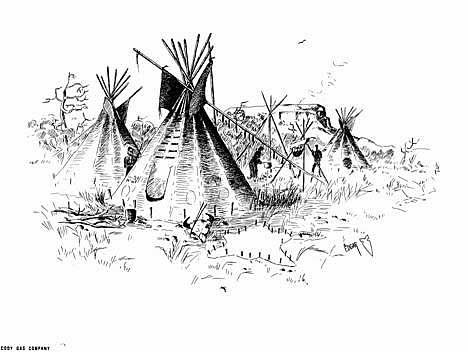
A Sketch by Bob Edgar for the Cody Gas Company
Bob's interest in history also began at an early age, from listening to the stories of sheepherders, cowboys and old characters while growing up, to going to old ghost town sites like "Kirwin" on the Wood River, Lee City on Sunlight Creek, various old abandoned building sites, and Virginia City, Montana. Also, he had started a collection of old guns and various items as a boy, along with his extensive collection of Indian artifacts.
For a length of time, Bob worked at Bill Phelps Conoco Station in Cody, which used to be where the Key Bank is now. It sounds like he spent more time keeping his Jeep running and working on guns than anything else.
In 1960 and 1961, Bob attended Northwest Community College and in 1960 started working for Dr. Harold McCracken at the Buffalo Bill Historical Center in the summer. McCracken was interested in developing an archaeological section in the museum. He soon became acquainted with Bob and after seeing his collection of pre-historic Indian artifacts and realizing that Bob had already explored a lot of the country in the Big Horn Basin, both on foot and by horseback, McCracken gave Bob the job of exploring for and recording ancient Indian sites in the mountains and foothills of the region. To save time in the mountains, Bob flew, several times, by helicopter, with Tip Cox, who was an experienced pilot. From the air they could locate caves, drive lanes for game traps, stone hunting blinds, and stone circles. Then these sites could be reached from the ground by foot or horseback.
Bob had been interested in the old log cabin near the DeMaris Springs road for some time. The old cabin had originally been built at the Arland and Corbett Trading Post, on Cottonwood Creek, five miles north of Cody in 1883. Bill DeMaris and Winold Wreiss, a German sculptor, moved it to this site in 1935. In 1960, Bob asked Sam Decker if he thought Bill would let him use it. Sam checked and Bill said Bob could lease it for one dollar a year. That way it would be legal. Then Bob and a friend, Fred Giles, put some windows back in it, fixed the door, plugged up the cracks, set up a wood cook stove, and put in a little furniture. It made a good place to do art work and stay from time to time. Eventually, some of Bob's, Fred's and Larry's friends started coming to the cabin. Sometimes to visit, sometimes to have a few drinks. After a few fights and a near shooting, they got that sort of activity stopped.
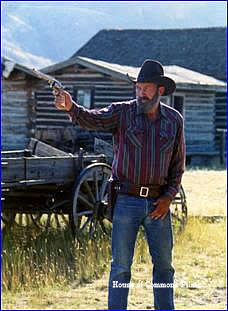
Bob on the Street of Old Trail Town - Photo: House of Commons
In 1960, Bob went on a college tour for high school assembly shows. His part in the show was to put on a shooting performance with Colt revolvers. He shot balloons out of an assistant's mouth and fingers with real bullets, through a mirror and other positions. He also did some fast draw shooting. This was the first of what became a fairly regular event. He has put on several similar shooting exhibitions every year since, including fourteen years of shooting glass balls in the air from horseback in parades around the area. Also Bob has done exhibitions in rodeo arenas and at the 100 year Buffalo Bill Wild West Show performance in 1983.
In 1962, George Dabich, who had spent many years in the mountains, joined Bob, with the Buffalo Bill Historical Center, in exploring for prehistoric Indian sites. They searched various regions from southwest Wyoming to central Montana, and even worked in a cave in the Big Horn Canyon before the water backed up from the dam. In 1962, they discovered that some Indian petroglyphs on the Big Horn River cliffs near Greybull were being defaced. The museum made arrangements to remove several panels from the cliff. Bob and George helped in the removal.
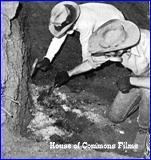
Excavating Mummy Joe - Photo: Bob Edgar Collection
In the summer of 1963, a cliff shelter cave that Bob had been aware of and knew was an Indian site, had been molested by collectors. In was realized that the site should be properly excavated before more damage was done. McCracken obtained a Forest Service permit through the museum to excavate the cave site. Bob Edgar and George Dabich began working in the cave in mid July 1963. Bob was in charge of the excavation. They thought that the site could be mapped, excavated, and recorded in one season. But as it turned out, it took four years to complete.
Buried within the forty foot deep deposit of dirt and gravel, which made up the cave floor, were thirty-eight levels of ancient Indian camp sites. As it turned out, the oldest level was almost ten thousand years old. In these camp levels where found arrow and spear points, stone and bone tools, wooden objects, cordage, basketry, tanned hide, bone, stone and shell beads, bones of animals the Indians had killed, and even one of the pre-historic hunters himself.
The man was mummified by the natural dryness of the cave. He still had his long black hair and was wrapped in a mountain sheep skin robe. The cave became known as " Mummy Cave." It contained the longest chronology of Indian occupation levels ever found in one site in the northern plains and Rocky Mountains. During the excavation of the site, Bob Edgar and George Davich were assisted at different times by Larry Edgar, Wayne Winter, Elbert Sowerwine, Bob Parnell, and during the last two seasons, by Wilfred Husted of the Smithsonian. Also there was occasional help and guidance from Waldo Wedel, senior scientist of the Smithsonian Institute, and John Moss.
In 1965 Bob married Terry Deutch of Sheridan. At that time, the Demaris land, west of Cody, was sub-divided and up for sale and it looked like they might lose the old Arland cabin. Terry was willing to live in it if it was fixed up. This pleased Bob, so they made a down payment on the parcel of land that the cabin was on and started making payments on the rest. They then chinked the walls better, sanded the inside of the logs, put in better windows, varnished the inside, and fixed it up for living in. They used a wood stove and hauled their water. They were living in the cabin during the last part of the Mummy Cave excavation.
By early winter of 1966, the excavating was finished. Bob was to go to the Smithsonian, and River Basin Survey Laboratory in Lincoln, Nebraska to help write up the scientific report on the Mummy Cave site. He and Terry spent that winter in Lincoln. On the way down Bob had to stop and excavate an ancient Indian burial site in the Black Hills for the Smithsonian. At Lincoln, Terry worked in the cafeteria in the old folks home while Bob worked on the Mummy Cave material. While there, Bob had an offer from Warren Caldwell, the director of the Smithsonian lab, to work with them and finish college at the University of Nebraska.
Bob had to make the decision between that, or coming back to Cody to collect the historical material that was in danger of being lost, now that there was a place to put it. It was decided to come back and start what was to become Old Trail Town.
Just before Bob and Terry went to Lincoln, Jim and Loris Bales, who were living on Russell Creek, told them about some cabins that were going to be destroyed on the Sunlight Ranch, which the Game and Fish had just bought. They got permission to remove one, so Bob and Jim with Terry and Loris, dismantled the cabin and got Mel Nading to haul the logs into Cody where they were stored for the winter. After getting back from Lincoln in the spring of 1967, they started assembling what was to become the first portion of the present house.
The summer of 1967 was spent working on the bigger cabin for the house and doing some final deep testing at the Mummy Cave, and Terry worked at the Cody Cafe. Early that fall, the first antique building was moved to the Old Trail Town site. It was the "Rivers" saloon which was built at the mouth of the Wood River west of Meeteetse in 1888. It was partly disassembled with the four walls and floor being moved intact. The saloon was later restored inside, similar to how it looked originally. This is the oldest saloon left in the Big Horn Basin. In the fall of 1968, Bob guided hunters and painted a few pictures and trapped that winter for money. It was hard to work on Trail Town and make enough money to live on.

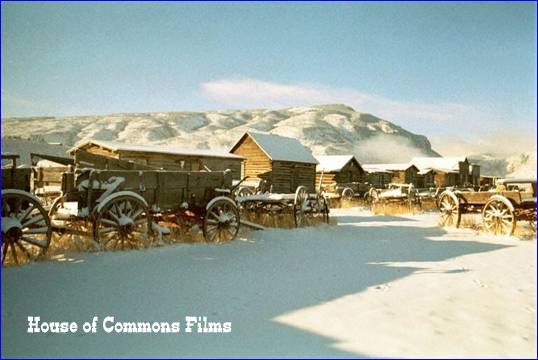
Photo: Old Trail Town – March 2001 – Photo House of Commons
The next twenty years of the collecting and building of Old Trail Town would take too long to tell in detail, so it will have to be condensed.
From the beginning, Trail Town was always open to people that wanted to stop and look around. At first it was just three buildings with several old wagons, a pile of antlers, a small display of guns, pictures, artifacts, and two Indian teepees.
Bob was already aware of quite a few old buildings in various locations, but he had to contact the owners and see if there was some way to acquire them. Most people were cooperative but some of the buildings took quite a while to acquire. Over half of the buildings were taken completely apart, hauled in on a large trailer, and pulled with a four-wheel drive pickup. Bob and at least one other helper usually did the heavy work.
Studying history and continuous searching paid off and Trail Town kept growing. In the fall of 1968, Bob became hunting manager on the Pitchfork Ranch, near Meeteetse, Wyoming, during the hunting season. He started working there when Cal and Margot Todd ran the ranch. He has been there ever fall since.
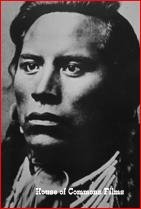
Custer’s Scout “Curley” - Photo: Park City Historical Society

Bob at the Graves in Old Trail Town -Photo: House of Commons
Also seven graves have been relocated at Trail Town. The first one was Jeremiah Johnson's grave. That was probably the largest burial service in Wyoming's history. Over two thousand people attended the re-burial service. Robert Redford, who played the part in the movie, was one of the pall bearers. Pete Fillerup has since sculpted a bronze statue of Johnson, which is now on the grave monument. The other people buried there are Jim White, a buffalo hunter; Jack Stilwell, army scout; Phillip Vetter, trapper killed by a grizzly; W.A. Gallagher and Blind Bill, cowboys killed in a feud near Meeteetse in 1894; and Belle Drewry, outlaw woman from Arland.
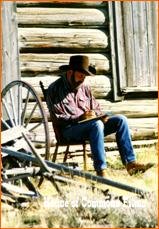
Bob the Author - Photo: House of Commons
Although Bob Edgar has been the guiding force and has been personally involved in all of the work at Trail Town, there has been a lot of cooperation from people all over the area in different ways. Terry has done her share of work. Tom Hillis of Stanton, Michigan helped on many projects including the sculpting of the Jim White bronze statue on the grave. The Pitchfork Ranch of Meeteetse has been a good supporter; Jim Bama, Tuff and Alice Renner, Randy Kruger, the Larsen Ranch, Russ Dupuis, Ralph Anthony, John Jones, and a long list of others, have helped in some way.
There is still a lot to do and Bob Edgar plans to spend his life working to preserve the heritage of Wyoming. He has coauthored three books: The Mummy Cave Project, Brand of a Legend, and Lady of a Legend. Currently he is doing research for a more complete book on the history of this region and Trail Town. Like Bob says, "There is a lot to do."

BOB EDGAR by Sherri Edgar (Edited by Ed Commons)
BIBLIOGRAPHY
The Cody Enterprise - June 1971 The Seattle Times - April 26, 1983 The Cody Enterprise - August 4, 1986 The Wyoming Liberty Bell - December, 1988
Brand of a Legend, Bob Edgar and Jack Turnell, Stockade Publishing, July, 1978.
"The Mummy Cave Project in Northwestern Wyoming," published by the Buffalo Bill Historical Center, 1978.
Interviewed Marjorie Edgar at her home in Cody, Wyoming, in February, 1989.
Interviewed Bob Edgar at home at Old Trail Town in February, 1989.